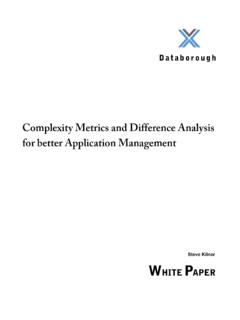Transcription of Executive Summary - Perfect Power
1 Executive Summary As electricity is entwined with every aspect of day-to-day life, the issue of reliability is paramount. In addition to the inconvenience experienced by consumers during prolonged periods without electricity service, a Power outage can literally mean the difference between life and death. From specialized care equipment such as dialysis machines to everyday heating and cooling devices like air conditioners or furnaces, the impact of a Power interruption on consumers can be significant. Interruptions can result in fatalities, injuries, days of lost productivity and thousands of dollars in production losses and equipment repairs. At GridWeek 2010, one utility Executive said, Utilities have a tradition of pursuing Perfect employee safety, but we haven't turned that thinking toward the customer experience.
2 When compared to our global competitors most notably Japan the has not kept pace in terms of reliability, and this gap comes at a significant cost. For a comparison of reliability between the and European countries, see Table 1. 1 Some studies estimate that Power interruptions cost the economy about $150 billion each year, or 4 cents/kWh (see Section 3). Fortunately, several innovative utilities and municipalities have made dramatic improvements in reliability without raising costs. This was accomplished in part by leveraging advanced quality methods such as Six Sigma and systems thinking. These entities include Naperville, Ill.; Austin Energy; Chattanooga, Public Service New Mexico, and Calgary, as well as campus settings such as the Illinois Institute of Technology and the University of California, Santa Barbara.
3 These success stories reveal the art of the possible and the path to perfection. It is the goal of the Galvin Electricity Initiative to create a roadmap to more efficient and reliable practices that serve the individual customer and the community as a whole practices that pay for grid improvements with savings from eliminating waste. In the search for workable solutions, the Initiative examined practices in the EU and more progressive states in the and suggests the following policy reform best practices should be adopted to address Power safety, reliability and Power quality deficiencies while also attracting investment and innovation: 1) A comprehensive set of consistent performance metrics should be developed and reported on a local government or microgrid level. This would allow communities across the country to benchmark grid performance.
4 These metrics also should reveal areas for improvement and identify leverage points, whereby small investments produce dramatic reliability improvements. The definition of a sustained outage should include major events such as storms. a. Reliability metrics should include at a minimum SAIFI, SAIDI, CAIDI, CEMMI-4, CELID-8, and MAIFI for the entire system and include all interruptions ( , major storms). These metrics should be reported by voltage level ( , below 34kV, 34kV to 138kV, and above 138kV) and by substation for each local government, for large developments and for customers served by a single meter or substation. Each category reflects fundamentally different design and cost structures. 1. Council of European Energy Regulators ASBL. (2008). 4th Benchmarking Report on the Quality of Electricity Supply.
5 Brussels: Council of European Energy Regulators (CEER), ASBL, 28 rue le Titien, 1000 Bruxelles, Arrondissement judiciaire de Bruxellese, RPM, i b. Emphasis on momentary interruptions should be significantly increased. As smart grid plans are implemented and more data on momentary interruptions becomes available, it should become easier to assess momentary outages and track improvements. The industry should consider additional metrics focused on momentary outages. c. Reliability metrics should include the reporting and trending of Power quality events. These include, at a minimum, voltage dips and swells, harmonic distortions, phase imbalance, and dropped phase(s). d. Utilities should include separate cost reporting categories to provide detail regarding the effectiveness of investments in reliability improvements.
6 This includes developing new cost sub- codes, separate from expense and capital, for reporting operations, maintenance, repairs and improvements. These new cost codes should be reported system-wide, for various voltage levels, by substation and by major customers/cities, as outlined in recommendation 1a. e. Utilities should report public deaths or injuries caused by Power interruptions or interactions with the distribution system. This should not include incidents downstream of the utility meter or in the home or customer facility. f. Reliability metrics and reporting should be continuously refined. g. Urban, rural and suburban circuits should be classified separately. Urban, suburban and rural circuits have different customer expectations, customer densities and threats. It does not make sense to have the same rules for all circuits in a utility's jurisdiction.
7 2) After establishing a baseline, create reliability targets or standards that ensure that all local governments, large developments and large customers receive similar service in terms of reliability, Power quality and cost. 3) A portion of the collected distribution rates should be applied to local grid improvements in coordination with a local government improvement plan. Some communities have not had improvements to their local distribution systems for 20 to 50 years. Local governments with reliability indices twice the average could receive greater allocations. 4) Expand and strengthen rules that limit the use of existing ratepayer fees for subsidizing distribution system expansion for new development. Using existing ratepayer fees to subsidize new development or acquire private distribution systems drains limited resources from improving the existing system.
8 An unintended consequence of subsidizing new development is less efficient, local all-electric designs. When electricity distribution is provided for free, other more efficient design options cannot compete. 5) Implement rules to allow local governments to invest in system improvements using long-term, on- bill financing mechanisms. See Illinois ComEd Rider LGC as an example. 2. 2. Commonwealth Edison Company. (2008, December 16). Rider LGC Local Government Compliance Adjustment. Retrieved from : ii 6) Implement rules that allow utilities to engage in Power quality and reliability service contracts for customers that wish to pursue performance better than current standards. Power -quality contracts are used in both the and Europe to supply higher-quality Power to customers who are willing to pay for it.
9 7) Consider encouraging the use of continuous improvement/quality methods in all aspects of operations, including smart grid programs. These proven methods include developing performance metrics and goals, as well as applying process mapping, failure modes and effects analysis, failure mode ranking and innovative solution set development and planning. The application of these methods eliminates waste and rework, while helping identify unintended consequences. Waste in the Electric Industry The reporting of repair costs or waste is critical to justifying investment in system reliability improvements. Major corporations measure waste and then invest to eliminate waste. The justification for investment is the elimination of the annual costs of waste. For example, if a utility is spending $100 million to repair overhead lines that fail each year because of storm damage, they could justify investing $700 million or more to move vulnerable system components underground where they would not be susceptible to storms.
10 Table 1: International Comparison of 2007 Reliability Indices COUNTRY SAIDI SAIFI. United States 240 Austria 72 Denmark 24 France 62 Germany 23 Italy 58 Netherlands 33 Spain 104 UK 90 Source: Council of European Energy Regulators ASBL. (2008). 4th Benchmarking Report on the Quality of Electricity Supply. Brussels: CEER. iii Glossary AMI automated meter infrastructure, but generally refers to an automated or smart-metering system Automated reclosers an older technology device used to automatically restore Power to faulted circuits CAIDI customer average interruption duration index CAIFI customer average interruption frequency index CEER Council of European Energy Regulators CELID-X customers experiencing longest interruption durations; CELID-8 is the percentage of customers who experienced outages exceeding 8 hours CEMI-X customers experiencing multiple interruptions; a measure of the percentage of customers who experienced X interruptions CEMMI-X customers experiencing multiple momentary interruptions.







